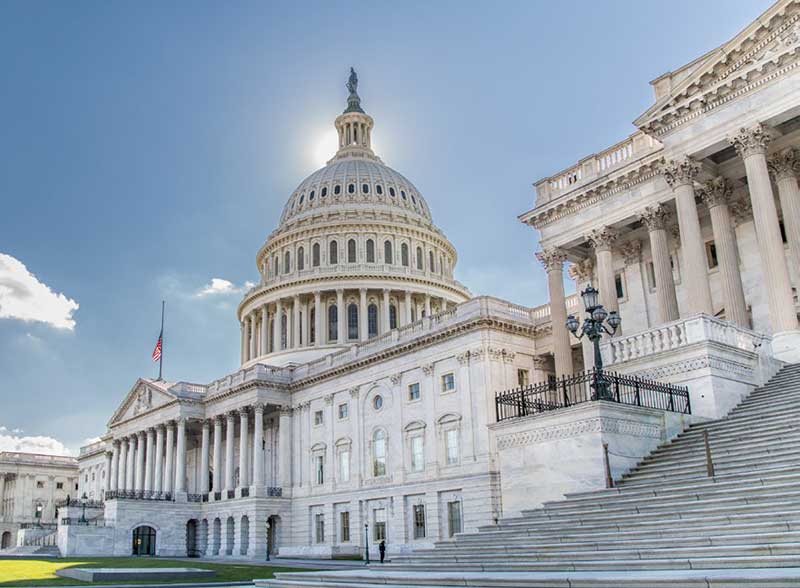
December 2020
Alston & Bird LLP and Aflac
The COVID-19 pandemic has made 2020 a year like no other. As the pandemic unfolded and the negative economic impact deepened, Congress and regulatory agencies responded, providing some welcome relief, as well as several new requirements for health plans. There has also been a variety of developments unrelated to the pandemic.

COVID-19 Developments
Congress reacted quickly in 2020 to pass legislation addressing a number of issues relating to the pandemic, including the Families First Coronavirus Response Act (FFCRA) and the CARES Act. Federal regulatory agencies also issued guidance in response to the pandemic. The COVID-19 provisions are generally temporary. Many have an uncertain end date tied to the end of the COVID-19 public health emergency or the national emergency. The COVID-19 public health emergency is determined by the Secretary of Health and Human Services (HHS) under the Public Health Service Act and is currently set to expire Jan. 20, 2021, and is likely to be extended. The national emergency was established pursuant to a declaration by President Trump under the National Emergencies Act.
Permitted reimbursement of over-the-counter (OTC) medicines and drugs
The Affordable Care Act (ACA) prohibited health Flexible Spending Arrangements (FSAs), Health Reimbursement Arrangements (HRAs) and Health Savings Accounts (HSAs) from reimbursing expenses for medicines and drugs (other than insulin) without a prescription. The CARES Act eliminated this restriction, effective for expenses incurred on or after Jan. 1, 2020. The legislation also provides that menstrual care products qualify as a reimbursable expense. Plan amendments will likely be required to take advantage of these changes for health FSAs and HRAs.
Required coverage of COVID-19 testing
FFCRA, as amended by the CARES Act, requires most group health plans to cover testing for COVID-19, including certain related items and services, without cost-sharing and without prior authorization or the use of medical management techniques. This mandate generally does not apply to plans that are not subject to ACA health coverage mandates, such as retiree-only plans and plans providing only excepted benefits (e.g., hospital indemnity and other fixed indemnity plans, cancer-only policies, and dental and vision plans); however, the mandate does apply to grandfathered plans. If testing is performed by an out-of-network provider, plans are required to pay the provider’s posted cash rate, unless another rate is agreed on. The testing mandate is generally effective starting March 18, 2020, and remains in effect through the COVID-19 public health emergency. Federal regulators issued two sets of FAQs providing more detail on the testing coverage requirement, which may be found here and here.
EAPs may cover COVID-19 testing and diagnosis
Qualifying employee assistance programs (EAPs) are excepted benefits, and therefore exempt from ACA health coverage requirements. One of the requirements for an EAP to qualify as an excepted benefit is that the EAP does not provide significant benefits in the nature of medical care. Federal regulators have issued guidance providing that, for the duration of the COVID-19 public health emergency or national emergency, diagnosis and testing for COVID-19 may be provided through an EAP. See Q&A 11 in this agency FAQ.
HSA/HDHP flexibility
The CARES Act permits telehealth and other remote care services, including services unrelated to COVID-19, to be provided below the High Deductible Health Plan (HDHP) deductible without adversely affecting HSA eligibility. The provision is effective for plan years beginning before Dec. 31, 2021. In addition, IRS Notice 2020-15 provides that HDHPs may provide benefits for testing and treatment of COVID-19 below the HDHP deductible without adversely affecting HSA eligibility. As noted above, the CARES Act now requires first-dollar coverage of COVID-19 testing. As of this writing, federal law does not mandate first-dollar coverage for COVID-19 treatments; however, some state laws do have such mandates for fully insured plans. Both the CARES Act telehealth provision and the relief in Notice 2020-15 may be applied retroactively to Jan. 1, 2020, (see IRS Notice 2020-29).

Required coverage of COVID-19 vaccines
Non-grandfathered group health plans are already required to provide certain preventive services, like vaccines, without cost sharing. Cost sharing in general can be imposed when a preventive service is delivered by an out-ofnetwork provider.
The CARES Act accelerates the timing for a COVID-19 vaccine to qualify as a mandated preventive service. The mandate is effective 15 business days after Dec. 13, 2020, which is the date the vaccine was recommended by the Centers for Disease Control. Additionally, cost sharing cannot be imposed regardless of whether it is provided by an inor out-of-network provider. Plans must pay a reasonable amount to out-of-network providers, such as the amount paid by Medicare.
Of note, the mandate applies to the administration of the vaccine, even when the vaccine itself is paid for by a third party such as the federal or state government. The mandate doesn’t apply to plans not subject to the ACA, so it doesn’t apply to retiree only plans, plans providing only excepted benefits (e.g., hospital indemnity and other fixed indemnity plans, cancer only policies and dental and vision plans).
Extension of certain COBRA and ERISA deadlines
The Department of Labor (DOL) and the IRS issued a notice extending certain deadlines for participants and beneficiaries and plan administrators, including deadlines relating to COBRA elections, special enrollment rights, external review and claims and appeals deadlines. These extensions have implications for employer-sponsored accident, health and disability plans, including excepted benefits. More information is in this Aflac COBRA and ERISA Advisory.
Additional flexibility for cafeteria plans and FSAs
In light of the unexpected changes from COVID-19, IRS Notice 2020-29 provides employers flexibility to allow additional mid-year cafeteria plan health coverage and FSA election changes, as well as other relief. The notice provides increased flexibility with respect to mid-year cafeteria plan elections during calendar year 2020 relating to group health coverage, health FSAs, and dependent care assistance plans. The notice also provides increased flexibility with respect to grace periods to apply unused amounts in health FSAs to medical expenses incurred through Dec. 31, 2020, and to apply unused amounts in dependent care assistance expenses incurred through Dec. 31, 2020. See the Aflac Advisory on Mid-Year Election Changes for more information.

Other COVID-19 relief provisions
COVID-19 relief legislation also includes a number of provisions intended to assist qualifying employers and employees, including the following:
Note that there are interactions that may affect the eligibility of a business that obtains a PPP loan to take advantage of the employee retention credit and the payroll tax deferral.

Non-COVID 2020 Developments
Legislative developments: ACA taxes and fees
Calendar year 2020 is the last year that the ACA health insurance tax (HIT) applies. The HIT is imposed on health insurers based on their relative market share of premiums for major medical plans and certain other health insurance plans. The HIT has an on again-off again history. It went into effect in 2010, was suspended for 2017, went back into effect in 2018, was again suspended for 2019, and went back into effect for 2020. Legislation enacted at the end of 2019 finally repealed the tax starting 2021. The same legislation also repealed the so-called “Cadillac tax” which would have gone into effect starting in 2022.
The Patient-Centered Outcomes Research Institute (PCORI) fee has been extended for 10 years (so that it now applies to plan years ending before Oct. 1, 2029). This fee is imposed on most self-funded and fully insured plans. Excepted benefit plans, including hospital indemnity and other fixed indemnity, specified disease or illness, and vision and dental policies, aren’t subject to the fee. The fee is the average number of lives covered under the plan multiplied by a dollar amount, which was originally set by the statute and is subsequently indexed for inflation. For policy and plan years ending after Sept. 30, 2019, and before Oct. 1, 2020, the applicable dollar amount is $2.54. For policy and plan years ending after Sept. 30, 2020, and before Oct. 1, 2021, the applicable dollar amount is $2.66. Additional information is on the IRS PCORI fee website.
Regulatory developments
Two new types of HRAs for 2020: Regulations finalized in 2019 create two new types of Health Reimbursement Arrangements (HRAs) for plan years beginning on or after Jan. 1, 2020. Individual coverage HRAs (ICHRAs) allow employers to help pay for premiums for qualifying individual market major medical coverage and out-of-pocket expenses not reimbursed by insurance. Among other requirements, ICHRAs cannot be offered to employees who are eligible for a traditional group health plan offered by the employer. Excepted benefit HRAs (EBHRAs) are designed to reimburse certain medical expenses for employees who are eligible to participate in a traditional group health plan offered by the employer (even if they are not enrolled in the traditional group health plan). The details of the rules for each new type of HRA are detailed and complex. A high-level summary is in the Aflac HRA Advisory. Applicable large employers offering ICHRAs need to consider how the ACA employer pay-or-play penalties apply. The IRS has issued proposed rules on ICHRAs and penalty issues, as well as nondiscrimination requirements. As of this writing, these rules have not been finalized.
DOL allows expanded use of electronic disclosure: The DOL finalized significantly modified electronic disclosure rules under ERISA. The new rule adds two new safe harbor methods: a “notice and access” method, which allows electronic delivery by posting information online; and email delivery, which allows electronic delivery directly by means of email. The new safe harbors are applicable only to pension and profit-sharing plans and do not apply to health and welfare plans (including FSAs and HRAs). It is possible that similar changes will be made in the future for health plans. One of the reasons for the delay in rules for health plans is the need to coordinate with other agencies (HHS and IRS) that also have jurisdiction over health plan issues.
New SBC template: Federal agencies introduced a new template for the Summary of Benefits and Coverage (SBC) to be used for plan years starting on or after Jan. 1, 2021. The template eliminates the reference to the ACA individual mandate and makes changes to the coverage examples. More information is on the DOL SBC webpage.
Prescription drug coupons and maximum out-ofpocket (OOP) limits: Federal regulators clarified that group health plans have the option to count manufacturer drug discounts toward the ACA maximum OOP limit (or not). Note that for fully insured plans, some state laws may require that coupons be counted for the OOP limit. Additional issues may arise for HDHPs that count the coupons toward the OOP max.

Transparency rules for group health plans: HHS, DOL, and IRS/Treasury finalized sweeping transparency regulations. In very general terms, these regulation rules include significant new requirements for nongrandfathered health plans and insurers of non-grandfathered health insurance coverage in the group and individual markets:
The rule doesn’t apply to excepted benefit plans, such as dental, vision, hospital indemnity and other fixed indemnity, and specified disease and critical illness policies.
Upcoming regulations: Some pending guidance has not been finalized at the time of this writing, but may be in the near future.
Benefit plan inflation adjusted amounts for 2021 for popular benefits
The following table provides a summary of key dollar limits for health and certain other employee benefits for 2020 and as adjusted for inflation for 2021.
| Benefit | 2020 | 2021 |
|---|---|---|
| HSA contribution max (including employee and employer contributions) | $3,550 ($7,100 family) | $3,600 ($7,200 family) |
| HSA additional catch-up contributions | $1,000 (this is not indexed) | Same |
| HDHP annual deductible minimum | $1,400 ($2,800 family) | Same |
| Limit on HDHP OOP expenses | $6,900 ($13,800 family) | $7,000 ($14,000 family) |
| ACA limit on OOP expenses | $8,150 ($16,300 family) | $8,550 ($17,100 family) |
| Health FSA salary reduction max | $2,750 | Same |
| Health FSA carryover max | $500 | $550 |
| Limit on amounts newly available under an Excepted Benefit HRA | $1,800 | Same |
| QSEHRA max reimbursement | $5,250 ($10,600 family) | $5,300 ($10,700 family) |
| Transit and parking benefits | $270 (monthly) | Same |
| 401(k) employee elective deferral max | $19,500 (Catch-up contributions $6,500) | Same |
| Highly compensated employee | $130,000 (applies for 2021 plan year under look-back rule) | $130,000 (applies for 2022 plan year under look-back rule) |
| Key employee | $185,000 | Same |

Conclusion
There are many new legislative and regulatory developments in 2020, with many highly influenced by the COVID-19 pandemic. This article provides a high-level summary of some key provisions. Employers should consult with their own advisers to understand what the changes mean for them. There may be other changes in 2020 that came too late to be noted in this article. Looking ahead, 2021 is also expected to be a busy year, with COVID-19 continuing to dominate the discussion, at least in the beginning of the year. The Supreme Court’s decision in the pending case challenging the constitutionality of the ACA is expected around June, but could be earlier. The outcome of that case will determine the future of the ACA and may prompt new legislative and regulatory responses.
The information above is provided for general informational purposes and is not provided as tax or legal advice for any person or for any specific situation. Employers and individuals should consult their own tax or legal advisers.
WWHQ | 1932 Wynnton Road | Columbus, GA 31999.